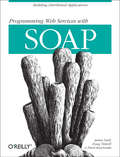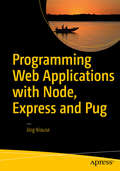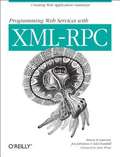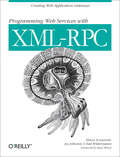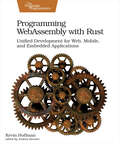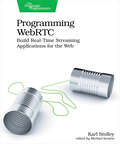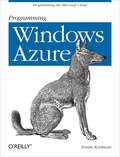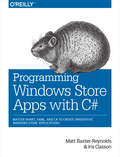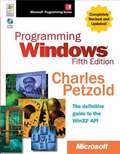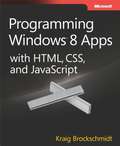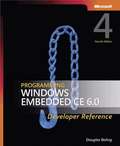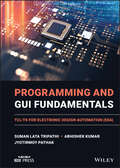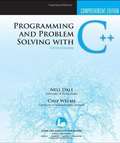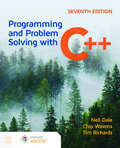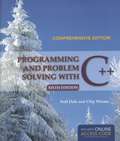- Table View
- List View
Programming WPF, 2nd Edition
by Chris Sells Ian GriffithsIf you want to build applications that take full advantage of Windows Vista's new user interface capabilities, you need to learn Microsoft's Windows Presentation Foundation (WPF). This new edition, fully updated for the official release of .NET 3.0, is designed to get you up to speed on this technology quickly. By page 2, you'll be writing a simple WPF application. By the end of Chapter 1, you'll have taken a complete tour of WPF and its major elements.WPF is the new presentation framework for Windows Vista that also works with Windows XP. It's a cornucopia of new technologies, which includes a new graphics engine that supports 3-D graphics, animation, and more; an XML-based markup language, called XAML, for declaring the structure of your Windows UI; and a radical new model for controls.This second edition includes new chapters on printing, XPS, 3-D, navigation, text and documents, along with a new appendix that covers Microsoft's new WPF/E platform for delivering richer UI through standard web browsers -- much like Adobe Flash. Content from the first edition has been significantly expanded and modified. Programming WPF includes:Scores of C# and XAML examples that show you what it takes to get a WPF application up and running, from a simple "Hello, Avalon" program to a tic-tac-toe gameInsightful discussions of the powerful new programming styles that WPF brings to Windows development, especially its new model for controlsA color insert to better illustrate WPF support for 3-D, color, and other graphics effectsA tutorial on XAML, the new HTML-like markup language for declaring Windows UIAn explanation and comparison of the features that support interoperability with Windows Forms and other Windows legacy applicationsWPF represents the best of the control-based Windows world and the content-based web world. Programming WPF helps you bring it all together.
Programming WPF: Building Windows UI with Windows Presentation Foundation
by Chris Sells Ian GriffithsIf you want to build applications that take full advantage of Windows Vista's new user interface capabilities, you need to learn Microsoft's Windows Presentation Foundation (WPF). This new edition, fully updated for the official release of .NET 3.0, is designed to get you up to speed on this technology quickly. By page 2, you'll be writing a simple WPF application. By the end of Chapter 1, you'll have taken a complete tour of WPF and its major elements. WPF is the new presentation framework for Windows Vista that also works with Windows XP. It's a cornucopia of new technologies, which includes a new graphics engine that supports 3-D graphics, animation, and more; an XML-based markup language, called XAML, for declaring the structure of your Windows UI; and a radical new model for controls. This second edition includes new chapters on printing, XPS, 3-D, navigation, text and documents, along with a new appendix that covers Microsoft's new WPF/E platform for delivering richer UI through standard web browsers -- much like Adobe Flash. Content from the first edition has been significantly expanded and modified. Programming WPF includes: Scores of C# and XAML examples that show you what it takes to get a WPF application up and running, from a simple "Hello, Avalon" program to a tic-tac-toe gameInsightful discussions of the powerful new programming styles that WPF brings to Windows development, especially its new model for controlsA color insert to better illustrate WPF support for 3-D, color, and other graphics effectsA tutorial on XAML, the new HTML-like markup language for declaring Windows UIAn explanation and comparison of the features that support interoperability with Windows Forms and other Windows legacy applications WPF represents the best of the control-based Windows world and the content-based web world. Programming WPF helps you bring it all together.
Programming Web Services with SOAP: Building Distributed Applications
by Pavel Kulchenko James Snell Doug TidwellThe web services architecture provides a new way to think about and implement application-to-application integration and interoperability that makes the development platform irrelevant. Two applications, regardless of operating system, programming language, or any other technical implementation detail, communicate using XML messages over open Internet protocols such as HTTP or SMTP. The Simple Open Access Protocol (SOAP) is a specification that details how to encode that information and has become the messaging protocol of choice for Web services.Programming Web Services with SOAP is a detailed guide to using SOAP and other leading web services standards--WSDL (Web Service Description Language), and UDDI (Universal Description, Discovery, and Integration protocol). You'll learn the concepts of the web services architecture and get practical advice on building and deploying web services in the enterprise.This authoritative book decodes the standards, explaining the concepts and implementation in a clear, concise style. You'll also learn about the major toolkits for building and deploying web services. Examples in Java, Perl, C#, and Visual Basic illustrate the principles. Significant applications developed using Java and Perl on the Apache Tomcat web platform address real issues such as security, debugging, and interoperability.Covered topic areas include:The Web Services ArchitectureSOAP envelopes, headers, and encodingsWSDL and UDDIWriting web services with Apache SOAP and JavaWriting web services with Perl's SOAP::LitePeer-to-peer (P2P) web servicesEnterprise issues such as authentication, security, and identityUp-and-coming standards projects for web servicesProgramming Web Services with SOAP provides you with all the information on the standards, protocols, and toolkits you'll need to integrate information services with SOAP. You'll find a solid core of information that will help you develop individual Web services or discover new ways to integrate core business processes across an enterprise.
Programming Web Applications with Node, Express and Pug
by Jörg KrauseLearn how to program modern web applications using the full Node.js platform, including Node.js on the server, Express for middleware and routing, and Pug (formerly Jade) to simplify the creation of views.Node.js is the foundation of all full JavaScript apps and plenty of books cover its full usage. This book focuses on how to use it to create server-based, modern web applications. Using Node.js alongside Express and Pug - the brand new version of Jade - you can create modern web applications solely using JavaScript. This book teaches you how to structure and build your app from scratch, and make development easy. What You Will LearnUse NodeJS in general and particularly the features require to create web applicationsUnderstand middleware and how to develop using the Express frameworkExplore the template engine Pug (formerly Jade) and how you can integrate it with ExpressSet up a complete development environment on both Linux and WindowsWho This Book Is For Developers of web applications who come from Java/J2EE, ASP.NET, PHP, Ruby on Rails and want to explore the capabilities of JavaScript based server apps. It’s suitable for beginners that have a basic understanding of JavaScript already.
Programming Web Services with Perl
by Pavel KulchenkoProgramming Web Services with Perlis written for Perl programmers who have no prior knowledge of web services. No understanding of XML-RPC or SOAP is necessary to be able to apply these technologies easily, through the use of publicly available Perl modules detailed in the book. If you're interested in applying XML-RPC and SOAP technologies to distributed programming applications, then Programming Web Services with Perlis a book you'll want to have.
Programming Web Services with XML-RPC
by Edd Dumbill Joe Johnston Simon St. LaurentXML-RPC, a simple yet powerful system built on XML and HTTP, lets developers connect programs running on different computers with a minimum of fuss. Java programs can talk to Perl scripts, which can talk to ASP applications, and so on. With XML-RPC, developers can provide access to functionality without having to worry about the system on the other end, so it's easy to create web services.
Programming Web Services with XML-RPC: Creating Web Application Gateways
by Joe Johnston Simon St. Laurent Dave Winer Edd Wilder-JamesHave you ever needed to share processing between two or more computers running programs written in different languages on different operating systems? Or have you ever wanted to publish information on the Web so that programs other than browsers could work with it? XML-RPC, a system for remote procedure calls built on XML and the ubiquitous HTTP protocol, is the solution you've been looking for.Programming Web Services with XML-RPC introduces the simple but powerful capabilities of XML-RPC, which lets you connect programs running on different computers with a minimum of fuss, by wrapping procedure calls in XML and establishing simple pathways for calling functions. With XML-RPC, Java programs can talk to Perl scripts, which can talk to Python programs, ASP applications, and so on. You can provide access to procedure calls without having to worry about the system on the other end, so it's easy to create services that are available on the Web.XML-RPC isn't the only solution for web services; the Simple Object Access Protocol (SOAP) is another much-hyped protocol for implementing web services. While XML-RPC provides fewer capabilities than SOAP, it also has far fewer interoperability problems and its capabilities and limitations are much better understood. XML-RPC is also stable, with over 30 implementations on a wide variety of platforms, so you can start doing real work with it immediately.Programming Web Services with XML-RPC covers the details of five XML-RPC implementations, so you can get started developing distributed applications in Java, Perl, Python, ASP, or PHP. The chapters on these implementations contain code examples that you can use as the basis for your own work. This book also provides in-depth coverage of the XML-RPC specification, which is helpful for low-level debugging of XML-RPC clients and servers. And if you want to build your own XML-RPC implementation for another environment, the detailed explanations in this book will serve as a foundation for that work.
Programming WebAssembly with Rust: Unified Development For Web, Mobile, And Embedded Applications
by Kevin HoffmanWebAssembly fulfills the long-awaited promise of web technologies: fast code, type-safe at compile time, execution in the browser, on embedded devices, or anywhere else. Rust delivers the power of C in a language that strictly enforces type safety. Combine both languages and you can write for the web like never before! Learn how to integrate with JavaScript, run code on platforms other than the browser, and take a step into IoT. Discover the easy way to build cross-platform applications without sacrificing power, and change the way you write code for the web. WebAssembly is more than just a revolutionary new technology. It's reshaping how we build applications for the web and beyond. Where technologies like ActiveX and Flash have failed, you can now write code in whatever language you prefer and compile to WebAssembly for fast, type-safe code that runs in the browser, on mobile devices, embedded devices, and more. Combining WebAssembly's portable, high-performance modules with Rust's safety and power is a perfect development combination. Learn how WebAssembly's stack machine architecture works, install low-level wasm tools, and discover the dark art of writing raw wast code. Build on that foundation and learn how to compile WebAssembly modules from Rust by implementing the logic for a checkers game. Create wasm modules in Rust to interoperate with JavaScript in many compelling ways. Apply your new skills to the world of non-web hosts, and create everything from an app running on a Raspberry Pi that controls a lighting system, to a fully-functioning online multiplayer game engine where developers upload their own arena-bound WebAssembly combat modules. Get started with WebAssembly today, and change the way you think about the web. What You Need: You'll need a Linux, Mac, or Windows workstation with an Internet connection. You'll need an up-to-date web browser that supports WebAssembly. To work with the sample code, you can use your favorite text editor or IDE. The book will guide you through installing the Rust and WebAssembly tools needed for each chapter.
Programming WebRTC
by Karl StolleyBuild your own video chat application - but that's just the beginning. With WebRTC, you'll create real-time applications to stream any kind of user media and data directly from one browser to another, all built on familiar HTML, CSS, and JavaScript. Power real-time activities like text-based chats, secure peer-to-peer file transfers, collaborative brainstorming sessions - even multiplayer gaming. And you're not limited to two connected users: an entire chapter of the book is devoted to engineering multipeer WebRTC apps that let groups of people communicate in real time. You'll create your own video conferencing app. It's all here. WebRTC is an API exposed in all modern web browsers. After almost a decade of development, the WebRTC specification was finalized, and this book provides faithful coverage of that finalized specification. You'll start by building a basic but complete WebRTC application for video chatting. Chapter by chapter, you'll refine that app and its core logic to spin up new and exciting WebRTC-powered apps that will have your users sharing all manner of data with one another, all in real time. No third-party libraries or heavy downloads are required for you or your users: you'll be writing and strengthening your knowledge of vanilla JavaScript and native browser APIs.You'll learn how to directly connect multiple browsers over the open internet using a signaling channel. You will gain familiarity with a whole set of Web APIs whose features bring WebRTC to life: requesting access to users' cameras and microphones; accessing and manipulating arbitrary user files, right in the browser; and web storage for persisting shared data over the life of a WebRTC call. Like any Web API, WebRTC doesn't enjoy a perfect implementation in any browser. But this book will guide you in writing elegant code to the specification, with backward-compatible fallback code for use in almost all modern browsers.Use WebRTC to build the next generation of web applications that stream media and data in real time, directly from one user to another - all by working in the browser.What You Need:Readers need a text editor, an up-to-date copy of Chrome or Firefox, and a POSIX-style command-line shell. They'll also need to install a little bit of open-source software, especially Node.js. All necessary setup is covered in full in the book's introductory chapter.
Programming Windows Azure: Programming the Microsoft Cloud
by Sriram KrishnanLearn the nuts and bolts of cloud computing with Windows Azure, Microsoft's new Internet services platform. Written by a key member of the product development team, this book shows you how to build, deploy, host, and manage applications using Windows Azure's programming model and essential storage services.Chapters in Programming Windows Azure are organized to reflect the platform's buffet of services. The book's first half focuses on how to write and host application code on Windows Azure, while the second half explains all of the options you have for storing and accessing data on the platform with high scalability and reliability. Lots of code samples and screenshots are available to help you along the way.Learn how to build applications using the Windows Azure toolsetDiscover how Windows Azure works under the hood, and learn the how and the why behind several featuresChoose to write application code in .NET or other languages such as C/C++, PHP, or RubyUnderstand the various options for managing your serviceGet up to speed on Azure's storage services, including blobs, queues, and tablesBuild a secure backup system, and learn about cloud application security, cryptography, and performance
Programming Windows Presentation Foundation
by Chris Sells Ian GriffithsWindows Presentation Foundation (WPF) (formerly known by its code name "Avalon") is a brand-new presentation framework for Windows XP and Windows Vista, the next version of the Windows client operating system. For developers, WPF is a cornucopia of new technologies, including a new graphics engine that supports 3-D graphics, animation, and more; an XML-based markup language (XAML) for declaring the structure of your Windows UI; and a radical new model for controls. Programming Windows Presentation Foundation is the book you need to get up to speed on WPF. By page two, you'll have written your first WPF application, and by the end of Chapter 1, "Hello WPF," you'll have completed a rapid tour of the framework and its major elements. These include the XAML markup language and the mapping of XAML markup to WinFX code; the WPF content model; layout; controls, styles, and templates; graphics and animation; and, finally, deployment. Programming Windows Presentation Foundation features: Scores of C# and XAML examples that show you what it takes to get a WPF application up and running, from a simple "Hello, Avalon" program to a tic-tac-toe game Insightful discussions of the powerful new programming styles that WPF brings to Windows development, especially its new model for controls A color insert to better illustrate WPF support for 3-D, color, and other graphics effects A tutorial on XAML, the new HTML-like markup language for declaring Windows UI An explanation and comparison of the features that support interoperability with Windows Forms and other Windows legacy applications The next generation of Windows applications is going to blaze a trail into the unknown. WPF represents the best of the control-based Windows world and the content-based web world; it's an engine just itching to be taken for a spin. Inside, you'll find the keys to the ignition.
Programming Windows Store Apps with C#: Master WinRT, XAML, and C# to Create Innovative Windows 8 Applications
by Iris Classon Matthew Baxter-ReynoldsIf you’re a .NET developer looking to build tablet apps, this practical book takes you step-by-step through the process of developing apps for the Windows Store. You’ll learn how to use Microsoft’s Modern UI design language with Windows 8.1 and WinRT 8.1.1 by building a line-of-business mobile app with C# through the course of the book.To develop the app, you’ll work with the same system details and design specs that apply to retail apps, such as persistence, backend service, and Windows 8 features for sharing and search. You’ll learn how to develop the code, incorporate third-party open source products, and package your app for the Windows Store.Build a UI with XAML and the Model/View/View-Model patternUnderstand asynchrony—and rediscover threads and parallelismStore data and system settings locally with SQLiteUse app bars for commands and the settings charm for Help optionsPresent notifications as tile updates, badges, or toast popupsHelp users visualize locations and tag activities to a mapEnable apps to share data and run side-by-side in the UIImplement functionality for running tasks in the background
Programming Windows Workflow Foundation: Practical WF Techniques and Examples using XAML and C#
by K. AllenFast-paced and to-the-point, this book takes you through the important topics of Windows WF development with clear explanations and practical example code. The book's selection of topics is driven by what the working developer needs to know. It is neither a comprehensive reference to the whole WF architecture, nor a strategy guide to the complete application development lifecycle. It's just what you as a C# developer need to know to use WF in your applications. This book is for .NET developers who want to enhance their applications with flexible workflow capabilities using Microsoft Windows Workflow Foundation. The author assumes that you have read other texts on the overall architecture of WF and on WF application design strategies, and instead focuses on real-work implementation issues for C# developers.
Programming Windows®
by Charles Petzold"Look it up in Petzold" remains the decisive last word in answering questions about Windows development. And in PROGRAMMING WINDOWS, FIFTH EDITION, the esteemed Windows Pioneer Award winner revises his classic text with authoritative coverage of the latest versions of the Windows operating system--once again drilling down to the essential API heart of Win32 programming. Topics include: The basics--input, output, dialog boxes An introduction to Unicode Graphics--drawing, text and fonts, bitmaps and metafiles The kernel and the printer Sound and music Dynamic-link libraries Multitasking and multithreading The Multiple-Document Interface Programming for the Internet and intranets Packed as always with definitive examples, this newest Petzold delivers the ultimate sourcebook and tutorial for Windows programmers at all levels working with Microsoft® Windows 95, Windows 98, or Microsoft Windows NT®. No aspiring or experienced developer can afford to be without it. An electronic version of this book is available on the companion CD. A Note Regarding the CD or DVD The print version of this book ships with a CD or DVD. For those customers purchasing one of the digital formats in which this book is available, we are pleased to offer the CD/DVD content as a free download via O'Reilly Media's Digital Distribution services. To download this content, please visit O'Reilly's web site, search for the title of this book to find its catalog page, and click on the link below the cover image (Examples, Companion Content, or Practice Files). Note that while we provide as much of the media content as we are able via free download, we are sometimes limited by licensing restrictions. Please direct any questions or concerns to booktech@oreilly.com.
Programming Windows® 8 Apps with HTML, CSS, and JavaScript
by Kraig BrockschmidtNOTE: This title is also available as a free eBook. It is based on Windows 8 Release Preview; the content and publication date will be updated for final Windows 8 software. Apply your existing skills with HTML, CSS, and JavaScript--and start building your own Windows 8 apps now. As a member of the Windows Ecosystem team, the author has trained hundreds of Microsoft engineers and has been on the front lines of bringing the first Windows 8 apps to the Windows Store. Through this book, you'll get a thorough grounding in platform features and considerations, and delve into development essentials. "Quickstart" sections provide ready experience with the tools, API, and core features. And you'll gain insights and best practices on design, coding, and performance from real-world developers working on real-world apps. Topics includes:Platform Characteristics App Anatomy and Page Navigation Controls, Control Styling, and Basic Data Binding Collections and Collection Controls Layout Windows 8 Style Commanding UI State, Settings, Files, and Documents Input and Sensors Media Purposeful Animations Contracts Tiles, Notifications, the Lock Screen, and Background Tasks Networking Devices and Printing Extensions Localization, Accessibility, and the Windows Store
Programming Windows® Embedded CE 6.0 Developer Reference
by Douglas BolingGet the popular, practical reference to developing small footprint applications--now updated for the Windows Embedded CE 6.0 kernel. Written by an authority on embedded application development, this book focuses in on core operating concepts and the Win32 API. It delivers extensive code samples and sample projects--helping you build proficiency creating innovative Windows applications for a new generation of devices. Discover how to: Create complex applications designed for the unique requirements of embedded devices Manage virtual memory, heaps, and the stack to minimize your memory footprint Create multithreaded processes and handle events Use the Storage Manager to manage disparate file systems and volumes Store simple groups of data with the database API Read and write registry data, and enumerate keys and values Schedule user, timer event, system event, and bubble notifications Connect to wired and wireless networks, PCs, and other devices Companion Web site includes: Code samples in Microsoft Visual C++ Files for sample projects
Programming Windows® Identity Foundation
by Vittorio BertocciGet hands-on guidance designed to help you put the newest .NET Framework component- Windows Identity Foundation, the identity and access logic for all on-premises and cloud development- to work.
Programming Windows®, Six Edition
by Charles Petzold<p>Programming legend Charles Petzold is rewriting his classic Programming Windows—one of the most popular programming books of all time—to show developers how to use existing skills and tools to build Windows 8 apps.</p>
Programming With Microsoft Visual Basic 2017 (Mindtap Course List)
by Diane ZakReaders learn to master the fundamentals of effective programming while working through Visual Basic 2017’s latest features with a wealth of hands-on applications -- all placed in context within this book's engaging real-world setting. PROGRAMMING WITH MICROSOFT VISUAL BASIC 2017, 8E by best-selling technology author Diane Zak offers an ideal introduction to programming with a dynamic visual presentation, step-by-step tutorials, and strategically placed activity boxes. New hands-on applications, timely examples, and practical exercises address a variety of learning styles. Even readers with no prior programming experience can learn how to effectively plan and create interactive Visual Basic 2017 applications right away.
Programming Workflow Applications with Domino
by Daniel Giblin Richard LamHarness the power of groupware to reshape business processes and customer interactions. This book will permit you to implement Web-based workflow applications using the industry-standard groupware environment, Domino R5. This work demonstrates how Lotus Notes/Domino can be used to deliver groupware applications through intranets, extranets and the Internet. It contains a reusable and customisable workflow application, with annotated source code created in the latest version of Notes.
Programming Your GPU with OpenMP: Performance Portability for GPUs (Scientific and Engineering Computation)
by Timothy G. Mattson Tom DeakinThe essential guide for writing portable, parallel programs for GPUs using the OpenMP programming model.Today&’s computers are complex, multi-architecture systems: multiple cores in a shared address space, graphics processing units (GPUs), and specialized accelerators. To get the most from these systems, programs must use all these different processors. In Programming Your GPU with OpenMP, Tom Deakin and Timothy Mattson help everyone, from beginners to advanced programmers, learn how to use OpenMP to program a GPU using just a few directives and runtime functions. Then programmers can go further to maximize performance by using CPUs and GPUs in parallel—true heterogeneous programming. And since OpenMP is a portable API, the programs will run on almost any system.Programming Your GPU with OpenMP shares best practices for writing performance portable programs. Key features include:The most up-to-date APIs for programming GPUs with OpenMP with concepts that transfer to other approaches for GPU programming.Written in a tutorial style that embraces active learning, so that readers can make immediate use of what they learn via provided source code.Builds the OpenMP GPU Common Core to get programmers to serious production-level GPU programming as fast as possible.Additional features:A reference guide at the end of the book covering all relevant parts of OpenMP 5.2.An online repository containing source code for the example programs from the book—provided in all languages currently supported by OpenMP: C, C++, and Fortran.Tutorial videos and lecture slides.
Programming and GUI Fundamentals: TCL-TK for Electronic Design Automation (EDA)
by Abhishek Kumar Suman Lata Tripathi Jyotirmoy PathakPROGRAMMING AND GUI FUNDAMENTALS Discover the foundations of TCL programming and GUI development Programming and GUI Fundamentals: Tcl-Tk for Electronic Design Automation (EDA), delivers a comprehensive exploration of the major design challenges and potential present in application and tool development with Tcl-Tk. Accessibly written and easy-to-understand, the book can be used by students at a variety of levels, as well as researchers and working professionals. The authors present the fundamental concepts of Tcl programming and graphic user interface (GUI) development using images, and photographs, assisting with concept understanding and retention. They describe real-time system designs and offer students and designers the opportunity to learn about critical concepts in scripting and GUI development. Readers will learn to design their own GUI, place and package widgets on the GUI, and allow EDA professionals, chip designers and students to code and design in TCL-TK. They will also benefit from: A thorough introduction to scripting languages and wish interpreters, including their fundamental concepts, TCL tips and tricks, and command, variable, and procedure examples Comprehensive explorations of the TCL data structure, including datatypes, strings and commands, lists and commands, and arrays and commands Practical discussions of TCL control flow, including conditional commands, multi-condition commands, and loop commands In-depth examinations of file input/output processing, including TCL file read-write, open and close commands, gets, and puts. Perfect for undergraduate and graduate students studying programming or computer science, as well as professionals working on electronic design automation and chip design, Programming and GUI Fundamentals: Tcl-Tk for Electronic Design Automation (EDA) is also an indispensable resource for programming professionals seeking to upskill.
Programming and Problem Solving with C++
by Nell Dale Chip WeemsCompletely revised and updated with the latest version of C++, the new Fifth Edition of Programming and Problem Solving with C++ provides the clearest introduction to C++, object-oriented programming, and software development available.
Programming and Problem Solving with C++
by Tim Richards Nell Dale Chip WeemsWidely accepted as a model textbook for ACM/IEEE-recommended curricula for introductory computer science courses, Programming and Problem Solving with C++, Seventh Edition continues to reflect the authors' philosophy of guiding students through the content in an accessible and approachable way. It offers full coverage of all necessary content enabling the book to be used across two terms, and provides numerous features to help students fully understand and retain important concepts from each chapter.


